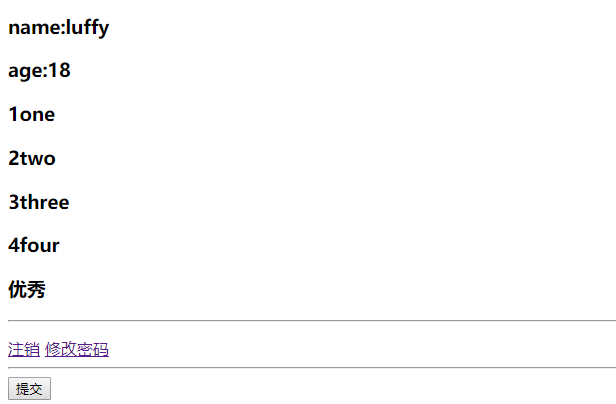1.简介
通过使用模板,就可以在URL中直接调用HTML,它还是松耦合的,灵活性强,而且更容易维护
而且可以将变量通过一定的方式嵌入到HTML中,最终渲染到页面,总的来说基于模板完成了数据与用户之间的交互
1.1模板HTML中的变量
用两个大括号括起来的文字(例如 {{ person_name }} )称为 变量 (variable)
url部分
urlpatterns = [ path("third/",views.indexs) ]
views部分
import datetime def indexs(request): hel = "hello" lis_year = [18, 22, 32] # 列表 dic = {"name": "luffy", "age": 18} # 字典 date = datetime.datetime.now() # 日期对象 class Person(object): def __init__(self, name): self.name = name person_1 = Person("zoro") # 自定义类对象 person_2 = Person("sanzhi") person_3 = Person("robin") person = [person_1, person_2, person_3] return render(request, "index.html", {"hel":hel,"l": lis_year, "dic": dic, "ship_data": date, "person_list": person})
templates部分(名称index.html)
<!DOCTYPE html> <html lang="en"> <head> <meta charset="UTF-8"> <title>Title</title> </head> <body> <h4>{{ hel }},</h4> <h4>my name is {{ dic.name.upper }}.</h4> {# 句点符引用对象的方法 #} <h4>I'm {{ l.0 }}'s old.</h4> {# 视图对象索引0的值 #} <h4>and my born year is {{ ship_data|date:"y-m-d" }}.</h4> {% for name in person_list %} {# 遍历每一个元素 #} <h4> my partner is {{ name.name }}</h4> {# 类对象列表 #} {% endfor %} {# 必须要包含结束标志 #} </body> </html>
# 注意这里调用字符串的方法时并* 没有* 使用圆括号 而且也无法给该方法传递参数;你只能调用不需参数的方法
最终效果

1.2模板语法
1.2.1 过滤器模板
default
default # 如果一个变量是false或为空,使用给定默认值,否则使用变量的值
{{value|deafult:"666"}}
length
length # 返回值的长度,如 value 是 ['a', 'b', 'c', 'd'],那么输出是 4
{{ value|length }}
filesizeformat
filesizeformat # 将值格式化为一个可读的文件尺寸,如 value 是 123456789,输出将会是 117.7 MB
{{ value|filesizeformat }}
date
date 如value=datetime.datetime.now()
{{ value|date:"Y-m-d" }}
slice
slice # 切片
{{ value|slice:"2:-1" }}
truncatechars
truncatechars # 截断,如果字符串字符多于指定的字符数量,那么会被截断。截断的字符串将以可翻译的省略号序列(“...”)结尾 参数:要截断的字符数
{{ value|truncatechars:9 }}
<p>截断字符:{{ content|truncatechars:20 }}</p>
<p>截断单词:{{ content|truncatewords:4 }}</p>
safe
safe # django会对模板中的语法自动转移,但是出于安全考虑,对于一些具有带链接跳转的功能标签则不会进行转义(如a标签)
{{value|safe}}
这里给演示一下safe的用法
url部分
from app01 import views urlpatterns = [ path('admin/', admin.site.urls), path('views/',views.views)
views部分
这里一开始我以为value这块是写在模板中,但是不是的,他属于视图部分,只是在模板这里添加了{{ value|safe}}这一步
def views(request): lis = ['das','two','three','four'] value = "<a href='http://www.baidu.com'>click</a>" # 这里使用locals直接将上面的参数封装成了字典形式 return render(request,'test.html',locals()) # return render(request,'test.html',{"lis":lis,"value":value})
templates部分(test.html)
<!DOCTYPE html> <html lang="en"> <head> <meta charset="UTF-8"> <title>Title</title> </head> <body> <h3>字典:{{ lis|slice:'1:-1' }}</h3> {{ value|safe }} </body> </html>
标签模板
for标签
遍历每一个元素
{% for person in person_list %}
<p>{{ person.name }}</p>
{% endfor %}
# 可以利用{% for obj in list reversed %}反向完成循环
遍历一个字典
{% for key,val in dic.items %}
<p>{{ key }}:{{ val }}</p>
{% endfor %}
# 这里循环序号可以通过{{forloop}}显示
forloop.counter The current iteration of the loop (1-indexed) forloop.counter0 The current iteration of the loop (0-indexed) forloop.revcounter The number of iterations from the end of the loop (1-indexed) forloop.revcounter0 The number of iterations from the end of the loop (0-indexed) forloop.first True if this is the first time through the loop forloop.last True if this is the last time through the loop
for...empty
# 在给出的组是空的或者没有被找到时,可以有所操作。
{% for person in person_list %}
<p>{{ person.name }}</p>
{% empty %}
<p>sorry,no person here</p>
{% endfor %}
if标签
# 对一个变量进行求值,如果它的值是“True”(存在、不为空、且不是boolean类型的false值),对应的内容块会输出
{% if num > 100 or num < 0 %}
<p>无效</p>
{% elif num > 80 and num < 100 %}
<p>优秀</p>
{% else %}
<p>凑合</p>
{% endif %}
with
# 用一个简单地名字缓存一个复杂的变量,当你需要使用一个“昂贵的”方法(比如访问数据库)很多次的时候是非常有用
{% with total=business.employees.count %}
{{ total }} employee{{ total|pluralize }}
{% endwith %}
csrf_token
csrf_token # 该标签用于跨站请求伪造保护
相关例子示例:
views部分
def temps(request): lis = [10,20,30,50] dic = {"name":"luffy","age":18} lis = ['one','two','three','four'] num = 80 login_user = 66 return render(request,'test.html',locals())
templates部分(test.html)
<!DOCTYPE html> <html lang="en"> <head> <meta charset="UTF-8"> <title>Title</title> </head> <body> {% for num in lis %} <h3> {{ num|add:100 }}</h3> {# 这里可以加减,带负号即可,没有乘除 #} {% endfor %} {% for k,v in dic.items %} {# 注意这里是dic.items #} <h3>{{ k }}:{{ v }}</h3> {% endfor %} {% for temp in lis %} <h3>{{ forloop.counter }}{{ temp }}</h3> {# 从1开始排 #} {% endfor %} {% if num >= 80 and num < 100 %} {# 注意空格,不然会飘红 #} <h3>优秀</h3> {% elif num >= 60 and num < 80 %} <h3>良好</h3> {% elif num < 60 %} <h3>不及格</h3> {% else %} <h2>出错啦</h2> {% endif %} <hr> {% if login_user %} <p>{{ login_user.name }}</p> <a href="">注销</a> <a href="">修改密码</a> {% else %} <a href="">登陆</a> <a href="">注册</a> {% endif %} <hr> <form action="" method="post"> {% csrf_token %} {# 用于伪造保护,否则django会拒收报forbidden #} <input type="submit"> </form> </body> </html>
效果
